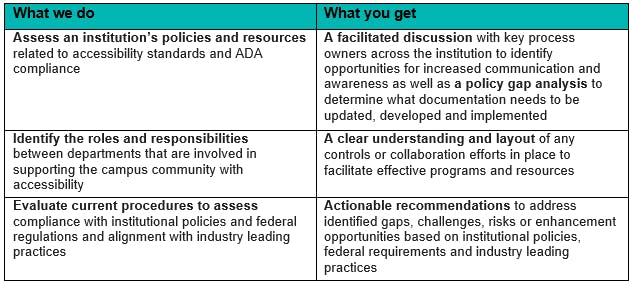As recipients of Title IV federal funds (i.e., financial aid), nearly all U.S. colleges and universities are subject to the Americans with Disabilities Act (ADA) and Sections 504 and 508 of the Rehabilitation Act of 1973 (Rehabilitation Act).
The ADA provides broad nondiscrimination protection in employment, public services and public accommodations for individuals with disabilities. Under the ADA, both public and private colleges and universities are required to provide equal access to postsecondary education, including extracurricular activities for students with disabilities.
Section 504 of the Rehabilitation Act prohibits discrimination on the basis of physical or mental disability. In 1998, Congress enacted Section 508 to reduce the obstacles in information technology for people with disabilities by requiring electronic and information technology to be accessible to people with disabilities, including employees and members of the public.
The inconsistences and the unknown
A rise in compliance review requests from the Office of Civil Rights (OCR), lawsuits with national associations and grievances filed by individual community members (students, faculty, staff, etc.) has increased the level of scrutiny institutions face.
As a new semester begins and a new community is welcomed, the ADA is in place to ensure equal access and opportunity for everyone in it. But what happens if disability barriers are unknown or internal controls are inconsistently maintained?
Trending risks
Governance
- Discriminatory admission and enrollment practices
- Loss of accreditation and/or funding
Process
- Failing to provide a reasonable accommodation
- Student accommodation requests are not reviewed and/or addressed in a timely manner
Technology
- Learning Management System (LMS) does not accommodate screen reader functions
- Public-facing websites are not accessible to all individuals
Other risks to consider
- Decentralized oversight of webpage
- Purchasing system, software or technologies with noncompliant features
- Financial limitations to provide for accommodations
- Limited access to assistive technologies in some physical locations or buildings
In addition to failing to support the campus community, non-compliance with ADA regulations and standards may result in legal, financial and reputational risks.
What can institutions do?
Colleges and universities should take the necessary next steps to anticipate, establish and maintain internal controls to make physical and web content accessible to people with disabilities and remain in compliance with regulatory requirements by considering the following:
- Formally documenting all policies and procedures (e.g., grievances, temporary leave, academic accommodations, housing/transportation accommodations, etc.)
- Mandating or strongly encouraging training for faculty members
- Administering regular website compliance crawler audits
- Establishing a mechanism to report accessibility barriers
- Conducting instructional design reviews for accessibility
Baker Tilly can help
We can help your institution take a proactive approach to evaluate the current state of your policies, processes and internal controls related to accessibility to identify enhancement opportunities for your campus community.




